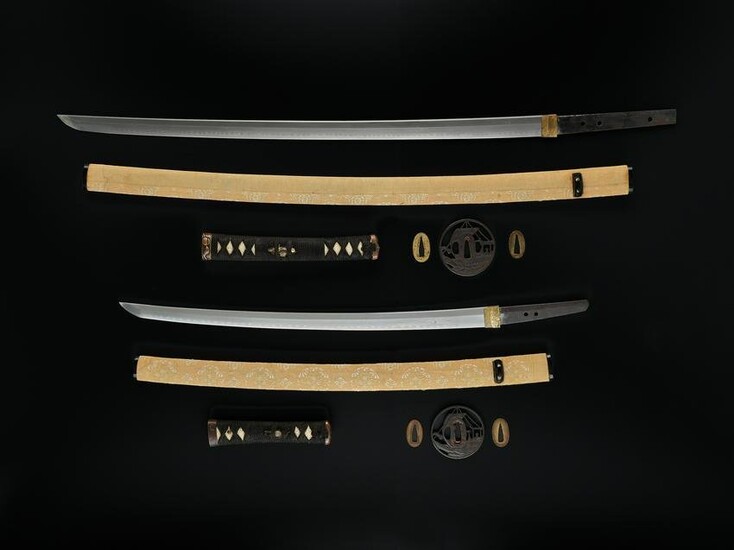KANEMOTO: A DAISHO INCL. KATANA AND WAKIZASHI
KANEMOTO: A FINE MINO SCHOOL DAISHO CONSISTING OF A KATANA AND WAKIZASHI
The wakizashi by Kanemoto
Japan, 16th-17th century, late Muromachi (1336-1573) to early Edo period (1615-1868)
The blades:
The wakizashi with shinogi-zukuri and iori mune, with good niku, fumbari, exhibiting an older sashikomi polish, the hamon is sanbonsugi with togari elements, the hamon in nioi-deki, the hada is itame nagare. The nakago is suriage with machi-okuri, two mekugi-anas, the yasurime is higaki, the tip is kuri jiri, the mei (signature) reads KANEMOTO.
The katana, also exhibiting an old sashikomi polish, with shinogi-zukuri and iori mune, ko-kissaki, the hamon is sanbonsugi with togari elements, the hamon in nioi-deki with sunagashi, the hada is mokume, o-itame. The nakago is suriage with machi-okuri, three mekugi-anas, the yasurime is kiri and the tip is kiri.
The mountings:
Each with an iron tsuba of maru gata form with one hitsu, executed in sukashibori to depict a sailing boat, a partly gilt copper fuchi with a hossu and mokugyo in relief, a partly gilt copper kashira depicting Hotei smiling in his sack, shakudo and gold menuki with seashells, a gilt habaki with distinct file marks, dew drops, and clouds. The tsukas covered in rayskin and wrapped in black textile. The sayas wrapped in a yellow silk brocade decorated with floral roundels.
NAGASA 51 cm (the wakizashi) and 66.3 cm (the katana), LENGTH 75 cm (the wakizashi koshirae) and 99 cm (the katana koshirae)
Condition: The blades in very good condition with minor surface wear. The mounts in good condition with some wear, particularly to gilt, few minuscule nicks, and soiling to the silk brocade.
Provenance: Hungarian private collection.
View it on
Sale price
Estimate
Time, Location
Auction House
KANEMOTO: A FINE MINO SCHOOL DAISHO CONSISTING OF A KATANA AND WAKIZASHI
The wakizashi by Kanemoto
Japan, 16th-17th century, late Muromachi (1336-1573) to early Edo period (1615-1868)
The blades:
The wakizashi with shinogi-zukuri and iori mune, with good niku, fumbari, exhibiting an older sashikomi polish, the hamon is sanbonsugi with togari elements, the hamon in nioi-deki, the hada is itame nagare. The nakago is suriage with machi-okuri, two mekugi-anas, the yasurime is higaki, the tip is kuri jiri, the mei (signature) reads KANEMOTO.
The katana, also exhibiting an old sashikomi polish, with shinogi-zukuri and iori mune, ko-kissaki, the hamon is sanbonsugi with togari elements, the hamon in nioi-deki with sunagashi, the hada is mokume, o-itame. The nakago is suriage with machi-okuri, three mekugi-anas, the yasurime is kiri and the tip is kiri.
The mountings:
Each with an iron tsuba of maru gata form with one hitsu, executed in sukashibori to depict a sailing boat, a partly gilt copper fuchi with a hossu and mokugyo in relief, a partly gilt copper kashira depicting Hotei smiling in his sack, shakudo and gold menuki with seashells, a gilt habaki with distinct file marks, dew drops, and clouds. The tsukas covered in rayskin and wrapped in black textile. The sayas wrapped in a yellow silk brocade decorated with floral roundels.
NAGASA 51 cm (the wakizashi) and 66.3 cm (the katana), LENGTH 75 cm (the wakizashi koshirae) and 99 cm (the katana koshirae)
Condition: The blades in very good condition with minor surface wear. The mounts in good condition with some wear, particularly to gilt, few minuscule nicks, and soiling to the silk brocade.
Provenance: Hungarian private collection.



